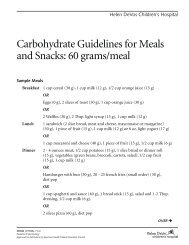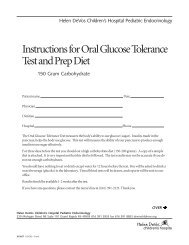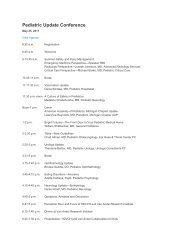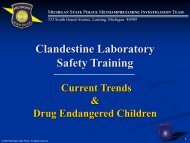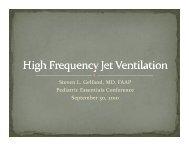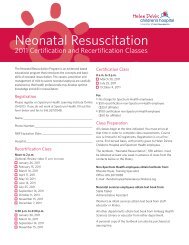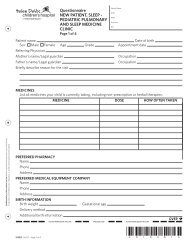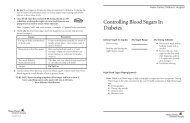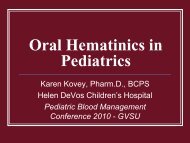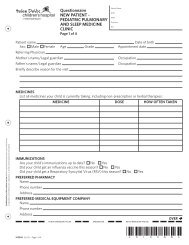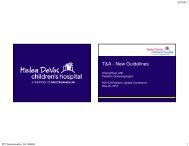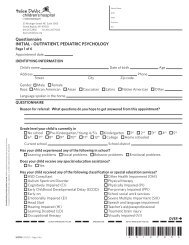Cerebral Palsy Care Guidelines - Helen DeVos Children's Hospital
Cerebral Palsy Care Guidelines - Helen DeVos Children's Hospital
Cerebral Palsy Care Guidelines - Helen DeVos Children's Hospital
You also want an ePaper? Increase the reach of your titles
YUMPU automatically turns print PDFs into web optimized ePapers that Google loves.
<strong>Cerebral</strong> <strong>Palsy</strong> <strong>Care</strong> <strong>Guidelines</strong>Table of Contents<strong>Cerebral</strong> <strong>Palsy</strong> <strong>Care</strong> <strong>Guidelines</strong> ........................ 1I Definition .......................................................................... 1II Purpose of <strong>Cerebral</strong> <strong>Palsy</strong> Guideline. .................................................... 1III Key Areas Addressed by <strong>Cerebral</strong> <strong>Palsy</strong> Guideline .......................................... 1IV Management:. ....................................................................... 2A History. ......................................................................................... 21 The complete medical history includes: .......................................................................22 Developmental History ....................................................................................23 Social History. ...........................................................................................24 Educational/Therapy History. ...............................................................................2B Physical Exam. .................................................................................... 31 Growth Parameters. ......................................................................................32 Vital Signs ...............................................................................................33 Complete Physical Exam ...................................................................................3C Management of Associated Problems in Children with <strong>Cerebral</strong> <strong>Palsy</strong> ........................................ 41 Orthopedic .............................................................................................42 Spasticity ...............................................................................................43 Neurologic ..............................................................................................54 Pulmonary ..............................................................................................75 Gastrointestinal ..........................................................................................86 GU Problems ...........................................................................................117 Skin. ..................................................................................................118 Vision .................................................................................................129 Hearing. ...............................................................................................1210 Dental. ................................................................................................1211 Speech and Communications ..............................................................................1312 Pain. ..................................................................................................1313 Behavioral Problems .....................................................................................1414 Social Problems .........................................................................................1415 Sleep Problems. .........................................................................................1516 Educational Planning .....................................................................................1517 Financial Issues ..........................................................................................16V Summary ......................................................................... 16ii
<strong>Cerebral</strong> <strong>Palsy</strong> <strong>Care</strong> <strong>Guidelines</strong>Box I: Abnormal Signs Associated with <strong>Cerebral</strong> <strong>Palsy</strong>. ..................................... 17Box II: Frequently Ordered Equipment for Children with CP ................................ 19Box III: Early Intervention Services ..................................................... 20Box IV: First Aid for Seizures. .......................................................... 24Box V: Hydrocephaly (Congenital or Acquired, Communicating or Obstructive) ................ 26Box VI: Assessment Tests Relating to GERD. .............................................. 27Box VII: <strong>Guidelines</strong> for Pediatric Medical Home Providers. .................................. 29Box VIII: Resources for Parents and Professionals .......................................... 30Box IX: CP Publications for Parents ..................................................... 32Box X: Definitions. ................................................................... 33Box XI: Diagnostic Codes. ............................................................. 34Box XII: References .................................................................. 35Table I: Measuring Children with CP Segmental Measurements .............................. 41Table II: Primitive Reflexes ............................................................ 42Table III: <strong>Guidelines</strong> for Prescribing Drugs for Children with CP and Movement Disorders. ....... 44Table IV: Monitoring Antiepileptic Medications ............................................ 46Table V: Medications Used for Drooling .................................................. 49Table VI: Medications Used for GERD. ................................................... 50Table VII: Medications for Constipation .................................................. 51Table VIII: Common Potential Contributors to the Experience of Pain in Children with CP ....... 53Table IX: Medications Used to Help Sleep Issues .......................................... 55Table X: CP <strong>Guidelines</strong> Birth to 12 Years ................................................. 56iii
<strong>Cerebral</strong> <strong>Palsy</strong> <strong>Care</strong> <strong>Guidelines</strong><strong>Cerebral</strong> <strong>Palsy</strong> <strong>Care</strong> <strong>Guidelines</strong>IDefinition<strong>Cerebral</strong> <strong>Palsy</strong> (CP) describes a group of permanent disorders of the development of movement andposture, causing activity limitation, that are attributed to non-progressive disturbances that occurredin the developing fetal or infant brain. The motor disorders of cerebral palsy are often accompaniedby disturbances of sensation, perception, cognition, communication, and behavior, by epilepsy, and bysecondary musculoskeletal problems.(2006 Executive Committee report).IIPurpose of <strong>Cerebral</strong> <strong>Palsy</strong> GuidelineTo provide effective chronic care management for children with cerebral palsy and their families.Management is primarily aimed at improving and maintaining functional abilities, preventing complications,and helping the child and family maximize their potential to participate in every day life.IIIKey Areas Addressed by <strong>Cerebral</strong> <strong>Palsy</strong> Guideline• To assist the medical home in the management of problems encountered in a child with <strong>Cerebral</strong><strong>Palsy</strong> (CP).• To reduce delays in treatment and minimize loss of function and potential.• To encourage family-centered care.• To facilitate decision making for timely referrals to specialists.• To develop timelines for laboratory evaluations and x-rays.• To enhance the communication system between consultants, hospitals, schools, agencies, families,and the primary care provider.• To enhance effective utilization of resources for children with cerebral palsy.• To improve record sharing with families.1
<strong>Cerebral</strong> <strong>Palsy</strong> <strong>Care</strong> <strong>Guidelines</strong>IVManagement:Routine care should follow the AAP guidelines for standards of preventative care.A History1 The complete medical history includes:• Prenatal and perinatal birth events.• Diagnostic studies including CTs, MRIs, ultrasounds, and lab data.• Medications (OTC, PRNs, prescriptions).• Immunizations and allergies.• Surgeries, hospitalizations and specialists involved.• Family medical history.• Review of systems.2 Developmental History• Timing and status of fine and gross motor skills, and of receptive and expressive languagedevelopment.• Personality and behavior description of the child, from the parents perspective.• Self injurious behaviors.3 Social History• Family living arrangement, community resource involvement, financial burden, financialresources (including insurance coverage).• Durable Medical Equipment (DME) provider, nursing agency, pharmacy.4 Educational/Therapy HistoryCurrent educational resources being utilized including: early intervention programs, specialeducation involvement, Physical Therapy (PT), Occupational Therapy (OT), Speech Therapy(SLP), Public Health Nurse (PHN) or Dietitian (RD) usage, and skilled nursing involvement.2
<strong>Cerebral</strong> <strong>Palsy</strong> <strong>Care</strong> <strong>Guidelines</strong>B Physical Exam1 Growth Parameters• Height, weight, head circumference, height for weight or body mass index. (Document asto how height is obtained).See Table I, Measuring Children with CP Segmental Measurements.• Should be charted using syndrome specific growth charts, if applicableClick to go to the “Growth References for Children with Quadriplegic <strong>Cerebral</strong> <strong>Palsy</strong>”page on the Kennedy Krieger Institute Web site.• A special note made relating to microcephaly, macrocephaly, or plagiocephaly2 Vital Signs• Temperature, pulse, respirations, and blood pressure• Obtain pulse oximetry if on oxygen.3 Complete Physical ExamA complete physical exam should be performed with identification of any physical characteristicsassociated with <strong>Cerebral</strong> <strong>Palsy</strong>. Musculoskeletal assessment should include a comprehensiveassessment of motor functioning, including hypotonicity, hypertonicity (spasticity),and weakness of proximal and distal muscle groups.The ability to perform gross motor movements should be assessed as well as assessing gaitfor ataxia or dysmetria, dystonia or disequilibrium. The ability to perform fine motor movementswith age appropriate testing needs to be assessed. The position of limbs at rest andwith motion should be observed. Contractures and rigidity should be assessed and documented,as well as limb asymmetry and muscle mass. The neurological assessment shouldinclude extensor and flexor tone. Deep tendon reflexes need to be assessed for hyporeflexia,hyperreflexia, or clonus (sustained or unsustained). The babinski response and persistentprimitive reflexes are commonly seen.See Table II, Primitive Reflexes.• Special attention needs to be paid to any skin breakdown.• Note child’s visual tracking, hearing.• Cranial Nerves II–XII status.See Box I, Abnormal Signs Associated with <strong>Cerebral</strong> <strong>Palsy</strong>.3
<strong>Cerebral</strong> <strong>Palsy</strong> <strong>Care</strong> <strong>Guidelines</strong>C Management of Associated Problems in Children with <strong>Cerebral</strong><strong>Palsy</strong>1 Orthopedica. <strong>Care</strong>ful examination of extremities for contractures and other bony abnormalities isnecessary at each physical exam. Physical examination is not always reliable. An anteroposteriorX-ray of the pelvis is required for diagnosis. All children who cannot walkmore than 10 steps by the age of 30 months should have a hip x-ray to measure migrationpercentage of each hip, and this should be repeated every 6–12 months until the ageof 7 years, or when further deformity is unlikely. Spine X-rays should be considered forall children in Gross Motor Function Classification System (GMFCS) groups IV to V whoare unable to stand by the age of 5 years, at 5 years and at 10 years as a minimum.Click to open the “Gross Motor Function Classification System for <strong>Cerebral</strong> <strong>Palsy</strong>”document from the CanChild Web site.b. Children with cerebral palsy need regular monitoring for scoliosis (64%) and kyphosis.c. All children with cerebral palsy with abnormal hip or spine exam or radiography need abaseline evaluation by an orthopedic surgeon.d. If the child is ambulatory, gait should be assessed. Computerized gait analysis can beprovided by a gait laboratory and is helpful in clinical decision making.e. The ordering of specialty durable medical equipment such as walkers, braces, standers, andwheelchairs, should be considered early and throughout the child’s life, but should be donein conjunction with the child’s therapist, orthotist, orthopedic surgeon, physiatrist, and family.See Box II, Frequently Ordered Equipment for Children with CP.2 SpasticityMuscle spasticity can be a significant source of functional disability in a child with CP. Treatmentplanning is centered on improving function, comfort, and care; reducing pain; and preventingor correcting deformity.a. Therapy is central to any treatment plan.• Physical therapy• Occupation therapy• Speech therapy––Oral Motor therapy• Other therapiesSee Box III, Early Intervention Services.4
<strong>Cerebral</strong> <strong>Palsy</strong> <strong>Care</strong> <strong>Guidelines</strong>b. Oral medication agents have the advantage of easy use but the disadvantage of systemicside effects.• Baclofen (Lioresal)• Carbamazepine (Tegretol)• Clonazepam (Klonopin)• Diazepam (Valium)• Dantrolene (Dantrium)• Tizanidine HCL (Zanaflex)See Table III, <strong>Guidelines</strong> for Prescribing Drugs for Children with CP and Movement Disorders.c. Referral for advanced spasticity management:• Neurolysis or neuromuscular blockade such as Botox or Phenol.• Intrathecal Baclofen (ITB)Click to go to the “Intrathecal Baclofen Therapy in Children” article on the MedscapeWeb site. (Note: You must be a member of the medscape.com Web site to login andview this article.)Warning: Patients with ITB pumps should be warned to seek medical treatmentat the first sign of pump or catheter failure. Symptoms may include an increase inspasticity, itching or fever.• Surgical, i.e., selective dorsal rhizotomy (SDR)Refer to a spasticity clinic, orthopedic surgeon, pediatric physiatrist, or a pediatric neurosurgeon,depending on community resources, and anticipated needs of child. Click togo to the “Advanced Management of Pediatric Spasticity Program” page of the Mary FreeBed Web site.3 Neurologica. SeizuresData from studies involving 1,918 children have found that on average 43% (35% to62%) of children with cerebral palsy develop epilepsy. Children with CP have a higherincidence of epilepsy than the general population, with onset within the first year oflife (47% versus 10%), history of neonatal seizures (28% versus 3%), status epilepticus(16% versus 1.7%), need for poly-therapy (25% versus 3%) and treatment with secondline anti-epileptic medication (31% versus 90%). Sixty-six per cent of children with CPwho have abnormal neuron-imaging studies are more likely to have epilepsy. Generalizedseizures are the most common (66%). Developmental disabilities are the most prevalent7, 59, 71symptomatic cause of seizures in children.Recommendations: An EEG should be obtained when a child with CP has a historyor examination features suggesting the presence of seizures or an epileptic syndrome,5
<strong>Cerebral</strong> <strong>Palsy</strong> <strong>Care</strong> <strong>Guidelines</strong>(Level A; Class I and II evidence).Routine review of antiepileptic drugs should occur at each maintenance visit. Collaborationwith child’s neurologist is necessary for seizure management.Safety precautions for seizures should be reviewed with parents regularly.See Box IV, First Aid for Seizures.See Table IV, Monitoring Antiepileptic Medication.b. HydrocephalusPersistent ventricular enlargement or persistent parechymal echodensities carry a 50%risk of CP, and large bilateral cysts in the periventricular white matter carry a risk of 75%to 95%.1)2)3)4)CT scan should be ordered as soon as soon as possible if concerned.Safety precautions/risks, and danger signs for children with hydrocephalus should bereviewed with parents.See Box V, Hydrocephaly (Congenital or Acquired, Communicating or Obstructive).An immediate referral to a neurosurgeon should be made if hydrocephalus is newlydiagnosed.A record of the shunt, and if possible, a drawing and explanation of the shunt shouldbe included in the chart.c. Neuroimaging is recommended in the evaluation of a child with CP if the etiology hasnot been established. (Level A, Class I and II evidence). MRI is preferred to CT scanningbecause of the higher yield of suggesting etiology and timing of insult leading to CP.(Level A, Class I and III evidence).Periventricular leukomalacia (PVL) is the predominant pattern of brain injury that latermanifests as spastic CP with variable degrees of cognitive impairment. The existence ofPVL is the strongest and most independent risk factor for the development of CP occurringin up to 80-85% of infants with PVL (Perlman, Risser & Broyses, 1996).d. Intraventricular bleeding in pre-term infants is associated with spastic diglegia, affectingmotor tone and control in the lower extremities more than the upper extremities. Morethan 50% of children with CP walk by 3 years of age, often with the assistance of orthoses,ambulation aids such as walkers or crutches.Since the advent of neuroimaging, it has become more apparent that children with CPmay have congenital brain malformation. Data from a group of 1,426 children found that7% who had a CT scan, and 12% who underwent a MRI had major brain malformationssuch as lissencephaly, schizencephaly, or polymicrogyria, or pachygyria.6
<strong>Cerebral</strong> <strong>Palsy</strong> <strong>Care</strong> <strong>Guidelines</strong>e. Genetic and metabolic disorders may (2%), on rare occasions, masquerade as CP. Observationover time indicates that neurological symptoms are progressive and generallysevere and should suggest the child does not have CP which mandates further evaluation.4 PulmonaryRespiratory illness is a frequent cause of mortality and morbidity in children with severe CP.Alterations in positioning caused by abnormal muscle tone, spasticity, immobility, scoliosis,and contractures can affect pulmonary function and place children with CP at high risk.a. PneumoniaPneumonia is the leading cause of death in children with severe CP, accounting for between30% and 50% of all deaths. Much of this is thought to be secondary to aspirationof food, saliva, or gastric contents. Frequent aspiration can lead to infections, pneumonia,and damage of the pulmonary defense system. Children who aspirate during feedingsneed a referral to a pediatric pulmonologist, and a clear plan to avoid repeated aspirationevents. This most likely includes dietary changes but may require an alternative source ofnutrition (i.e., Gastrostomy tube with or without a Nissen fundoplication).b. Restrictive Lung DiseaseChildren who have severe scoliosis (64%) or other spinal deformities may need pulmonaryfunction studies. These conditions make it difficult to position the child in a safeswallowing posture.c. Chronic Lung Disease of Infancy (CLD)Children who have CLD and are discharged on supplemental oxygen, should have thefollowing assessments performed regularly until they are off of supplemental oxygen:an interim history, measurement of weight, pulse oximetry reading at rest and duringfeeding. Consider RSV prophylaxis. Children discharged from the NICU on supplementaloxygen should also consult with a pulmonologist.d. DysphagiaThe incidence of dysphagia in children with CP is estimated to be about 40%. Childrenwith CP experience significant feeding and swallowing problems during the first 12months of life. This finding often precedes the diagnosis of CP. Symptoms include gagging,a wet vocal quality or fatigue with feedings. Dysphagia symptoms can be managed utilizingintensive therapy, advising food consistency management and positioning techniques.Dysphagia team members should include a speech/language pathologist, a dietitian, andan occupational therapist. The degree of problem and management frequently requires avideo swallow study.7
<strong>Cerebral</strong> <strong>Palsy</strong> <strong>Care</strong> <strong>Guidelines</strong>• Require an inordinately long time to feed (>30 minutes).• Have inadequate weight gain in spite of dietary interventions.• Have unsafe swallow on VFSS, or significant risk of aspiration of food during eating.Nutritional concerns may be life long. The earlier the need for adjunctive feeding is recognized,and instituted, the better the overall outcome for the child.The presence of a seizure disorder substantially increases the risk of developing GastroesophagealReflux Disease (GERD) that may indicate undergoing a prophylactic antirefluxprocedure at the time of the gastrostomy tube placement (Harrington, Brand,Edwards 2004).d. Gastroesophageal Reflux Disease (GERD)<strong>Cerebral</strong> palsy patients develop GERD with more frequency (26-91%) than the generalpopulation (5-7%). The major problem is recurrent vomiting (70%) and malnutrition(63%). GERD can be attributed to various factors such as vertebral column abnormalities,prolonged supine position, delayed gastric emptying time, gastrostomy, or psychogenicfactors. Other gastrointestinal symptoms such as nausea, abdominal distension,anorexia, early satiety, and constipation (52%) are also common in children with CP. Insome cases recurrent vomiting may be neurological.The mainstay of the management of GERD is more frequent smaller-volume meals. Insuringthat daily requirements are met, this approach alone may be successful. In neurologicallyimpaired children unresponsive to conventional anti-reflux treatments, a courseof a highly restricted diet with an amino-acid based formula may bring an immediate andsustained improvement. (JPGN, 35, 2002).For severe GERD and in association with other management methods, continuous feedsby NGT, gastrostomy or jejunostomy may be required.See Table VI, Medications Used for GERD.Medications used for gastrointestinal motility problems/slow gastric emptying.• Erythromycin (EES)• Metoclopramide (Reglan)Experience has shown that medical modes of treatment are less effective in childrenwith disabilities, who often require surgical intervention with a Nissen fundoplication.e. Constipation/EncopresisConstipation occurs in 25% of children with CP. Constipation is another manifestation ofa probable defect in neurologic control of the gut. Recognition and effective managementis necessary. Constipation is exacerbated by medication, immobility, and poor fluid intake.Constipation is associated with early satiety and is an additional reason for poor feedingand contributory to under nutrition.10
<strong>Cerebral</strong> <strong>Palsy</strong> <strong>Care</strong> <strong>Guidelines</strong>Inadequate fiber intake is one amiable causative factor. Consider Celiac disease in severecases of constipation with a total IgA and tissue transglutaminase.Low muscle tone or spastic abdominal muscles can prevent contractility and pressureto adequately advance and empty bowel contents. A lack of exercise and the inability tosense signals of a bowel movement can contribute to the problem. Bowel programs areoften a routine part of the care and should be addressed in maintenance visits.Medications: milk of magnesia, senna, miralax, lactulose.See Table VII, Medications for Constipation.f. ObesityObesity although uncommon, can occur in this population. The help of a dietitian in planningreasonable food intake is important. School coaches can also be involved in specialathletic programs for persons with handicaps to help with cardiovascular fitness andenergy expenditure.6 GU ProblemsBladder function should be assessed. The child with CP is likely to achieve continence later ifat all. Resources for the diapers of an older child, including diapers for swimming are availableonline:• Click to go to Diapers Online Web site.• Click to got to SwimOutlet Web site.Provisions should be made for diapers if incontinent past 3 years of age. In some states diapersare a covered expense by Medicaid if the child has a need over the age of 3 years.The presence of testes in the scrotum should be ascertained in the early years. A referralto a pediatric urologist or surgeon may need to be made. Hernias are a frequent problem,particularly in males, and should be assessed at each visit.Menarche history should be reviewed. Hygiene may be a concern. Suppression of menseswith contraceptives, oral or by injection may be considered. The AAP guidelines (1996) consensusstates that there is a definite need to discuss sexuality in order to protect girls withdisabilities from exploitation, unplanned pregnancy, or sexually transmitted diseases.7 SkinChildren with CP are at a greater risk for skin breakdown. The major problems are pressureulcers or friction areas, especially around splints or braces. Routine monitoring at every visitneeds to be done. Parents need to be taught to monitor the child’s skin daily to look forthe development of any areas of redness that continue more than 15 to 20 minutes followingremoval of the pressure source. The use of appropriate well fitting splints is extremelyimportant,11
<strong>Cerebral</strong> <strong>Palsy</strong> <strong>Care</strong> <strong>Guidelines</strong>8 VisionVision impairments are common (26%) and their prevalence increases with decreasing gestationalage. An assessment of visual behaviors in children with CP is often difficult becauseseveral problems can coexist, including ocular lesions, eye movement disorders, impairedacuity, various visual processing abnormalities, as well as attention deficits. An evaluation bya pediatric ophthalmologist within the first year of life is necessary. Vision should be checkedfor acuity, refractive errors (75%), strabismus (misalignment of the eyes), amblyopias (lazyeye), cataracts, nystagmus, optic atrophy, cortical blindness.Early correction of refractive errors in these children, before the neural plasticity period isfinished, must be implemented. Timely access and quality of care is especially important. ThePCP should document whether children who receive a diagnosis of a vision problem arereceiving appropriate interventions. An ophthalmologic examination should be performed atleast once yearly until the age of six. (AAP,2006).9 HearingChildren with CP have an increased incidence (5-15%) of hearing impairment. An assessmentof hearing should be done as with other newborns at birth. If there are emerging questions,a diagnostic BAER should be done in the first 3 months of life. For all infants who have riskfactors for hearing loss (VLBW, kernicterus, neonatal meningitis, abnormal neuroimagingstudies, severe HIE insults) who did pass the newborn inpatient screen, a diagnostic BAERshould be performed by 12 months of chronological age. If they did not pass the newbornhearing screening, a diagnostic BAER should be completed within 3 months of the failedscreen.If hearing loss is sensorineural (i.e., damage to auditory nerve or inner ear) rehabilitationshould be started by 6 months of chronological age. If hearing loss is conductive (i.e., anatomicalabnormalities and/or frequent otitis media), tympanometry can be helpful in diagnosingmiddle ear effusions and PE tubes may be necessary. A referral to an ENT physician maybe necessary. (Joint Committee on Infant Hearing et al, 2000).See Box VII, <strong>Guidelines</strong> for Pediatric Medical Home Providers.Older children should have yearly hearing evaluations.10 DentalMalocclusions commonly occur in children with CP as a result of orofacial muscle tone deficiencies.A child should receive an initial exam if there is any evidence of caries or abnormalities,otherwise by two years of age. Dental evaluations should continue on a six month basiswith a dentist experienced with children with CP. More frequently if the child is exclusivelygastrostomy fed. A sedation plan should be formed if this is necessary.12
<strong>Cerebral</strong> <strong>Palsy</strong> <strong>Care</strong> <strong>Guidelines</strong>Because of difficulties with oral hygiene, it is imperative these children receive fluoride accordingto current recommendations. Parents should be instructed in a reasonable homedental hygiene plan and it may be necessary to provide an electric toothbrush to do this. Asuction toothbrush may be necessary if aspiration is a concern.Gum hypertrophy should be assessed and treated in children who are taking medicationsthat promote it. (Phenytoin)Sealants are recommended for teeth with enamel defects.11 Speech and Communications38% of children with CP have speech and language impairment. Articulation disorders andimpaired speech intelligibility are usually present. Speech should be evaluated at the firstsign of delay and a treatment plan developed. Problems in articulation and dysarthrias arecaused by muscle tone abnormalities. Because of bilateral corticobulbar dysfunction in manyCP syndromes, anarthric or dysarthric speech and other impairments related to oral motordysfunction are common.Speech therapy should begin early – at the first indication of speech problems. Speech andlanguage therapy aims to maximize children’s ability to communicate through speech, gesture,and/or supplemental means such as communication aids that enable them to become independentcommunicators.If normal speech that functions effectively as communication is not emerging, alternatetechniques should be explored. Computers or adaptive communication devices (ACD) haveallowed children with speech problems to dramatically improve their communication. Signlanguage can also help even the very youngest communicate their needs.Language (as opposed to speech) deficits in CP go hand-in-hand with verbal intellectual limitationsassociated with cognitive impairment.Hearing should be evaluated in children if there is any speech delay and as part of routineevaluation.12 PainPain assessment and alleviation are a necessary part of health care for children with CP. Painmay be a problem for children with CP due, in part, to the inherent deficits associated withthe disease, as well as the invasive medical and surgical procedures and rehabilitative activitieschildren with CP undergo on a regular basis. Pain is the fifth vital sign according to theAmerican Pain Society.There are two primary categorizations for pain: acute and chronic. Acute pain is mostoften caused by tissue damage from irritation, related to injury, surgery, or disease. It lasts 6months or less. Persons with chronic pain may also experience depression, sleep disturbance,fatigue, and decreased overall physical functioning. Pain may also be associated with all thecommon contributors.See Table VIII, Common Potential Contributors to the Experience of Pain in Children with CP.13
<strong>Cerebral</strong> <strong>Palsy</strong> <strong>Care</strong> <strong>Guidelines</strong>A multitude of pharmacological interventions specific to each problem or complications aswell as non-pharmacological interventions such as distraction, relaxation training, biofeedback,and therapeutic massage (McGrath, 1990).Pain scales that can be used:• The non-communicating children’s pain checklist for children with neurodevelopmentaldisorders and severe cognitive impairment. McGarth et al (1998).• The Pediatric Pain Profile. Hunt et al (2004)• Pain assessment instrument for cerebral palsy.13 Behavioral ProblemsChildren with CP appear to have a higher (20%) incidence of ADHD than in the generalpopulation. Its presence should be sought and treated.As a result of an exaggerated and prolonged existence of primitive reflexes – especially thestartle reflex, infants and children with CP can over-react to the mildest stimulation. Therefore,they become tired, frustrated, irritable, demanding and uncooperative children. Childrencan develop self-injurious behavior (SIB). Parents need to be asked about this, and the childexamined since often that will not be elicited on routine questioning. Most SIB have a functionand are most responsive to behavioral modification. A functional behavioral assessmentcan be very helpful in the identification of the root cause of the SIB.A multi-disciplinary approach often has to be taken to check children for treatable problemssuch as reflux with esophagitis, constipation, dental problems, otitis media, hernia, gallbladderdisease, and seizures, with any sudden onset of undesirable behavior.Discipline is important and should be consistent and developmentally age appropriate (for achild’s mental age).Increased reports of depression in adolescents with cerebral palsy have also been reported.14 Social ProblemsAs a result of many problems associated with cerebral palsy, respite is usually an issue forparents with children with significant handicaps. For parents who wish to use it, there shouldbe provisions for hourly or day to day respite care. Respite may be beneficial, however maybe dependant on state funding and respite facilities. A plan should also include a long-termrespite for family vacations and/or in case of a family illness.Religious support can also be helpful for families.Exposure to social situations should be encouraged and planned.<strong>Care</strong>er planning should be initiated early so that appropriate plans can be made in theireducation.Discussions with families about long-term placement as the parent’s age should be initiatedwhen appropriate.14
<strong>Cerebral</strong> <strong>Palsy</strong> <strong>Care</strong> <strong>Guidelines</strong>15 Sleep ProblemsChildren with CP may struggle to initiate or maintain sleep. Central and obstructive sleepapnea can occur at a greater frequency in children with CP. Pain secondary to spasticity, GERor other problems may cause problems with sleep. A bedtime routines and setting limits isimportant. Evaluation may include sleep studies, swallowing studies, and PH probes.Some children will benefit from medications to assist in sleeping.• Melatonin — improves sleep wake cycle in children.• Clonidine (Catapres)• Trazadone (Nesyrel)See Table IX, Medications Used to Help Sleep Issues.Medications should be titrated slowly to avoid morning drowsiness. Ongoing assessments ofside effects and efficacy should take place.Spasticity can interfere with sleep and appropriate treatment may make sleep more restorative.Intrathecal baclofen therapy for spasticity has been shown to facilitate sleep by decreasingapneic events and reducing the disturbing involuntary leg movements.16 Educational PlanningMost children with cerebral palsy live at home with their families, attend regular classroomsat their neighborhood schools, and participate in a variety of natural community activities.Evaluations for educational assistance should be made as soon as the child shows any sign ofdevelopmental delays. In Michigan, educational support is guaranteed from age 0 through 25years. An assessment of educational placement should be made at each routine visit.At periodic intervals, a child should have psychometric testing done that is appropriate andtakes into account the handicaps of the child.As the child ages an assessment for independent living needs to be completed. As adultswith CP, most continue to live in community settings, but one third live at home with theirparents whose ability to continue care giving may decrease as they age. Twenty per cent ofadults with CP are ambulatory and 40% can walk with assistance; the remaining 40% arenon-ambulatory.15
<strong>Cerebral</strong> <strong>Palsy</strong> <strong>Care</strong> <strong>Guidelines</strong>17 Financial IssuesIt is important to assess whether they have been linked with routine financial supportsources such as Supplemental Security Income (SSI), WIC, MI Child, Medicaid and Childrenand Youth Special Health <strong>Care</strong> Services (CYSHCS) programs.Additional programs can be made available to parents such as “Make a Wish,” transportationprograms, and Easter Seal programs. Support groups are often helpful to families.• See Box VIII, Resources for Parents and Professionals.• See Box IX, CP Publications for Parents.VSummaryChildren with <strong>Cerebral</strong> <strong>Palsy</strong> present a special challenge to Health <strong>Care</strong> Providers because of theirunique developmental and medical differences. This Clinical Practice Guideline is intended to be usedas a reference guide when caring for children with <strong>Cerebral</strong> <strong>Palsy</strong> and their families. As such, the clinician’sclinical judgment should supersede these guidelines.• See Box X, Definitions.• See Box XI, Diagnostic Codes.• See Box XII, References.• See Table X, CP <strong>Guidelines</strong> Birth to 12 Years.16
<strong>Cerebral</strong> <strong>Palsy</strong> <strong>Care</strong> <strong>Guidelines</strong>Box I: Abnormal Signs Associated with<strong>Cerebral</strong> <strong>Palsy</strong>Delayed motor milestones• Not rolling by 6 months• Fisting after 5 months of age• Not sitting with support by 8 months• Not walking by 15-18 months• Discrepancies between cognitive and motor developmentPersistent or evolving increased or decreased muscle tone• Head lag beyond 6 months of age• Poor trunk control and balance• Opisthotonic posturing and extensor thrusting• Dystonia• Early rolling or standing (especially in high risk infant: rolling is achieved involuntarily by a reflexivelog roll or arching)• Toe walking/scissoring• Abnormal motor or gait patternsFocal abnormalities of movement, posture, tone• Declaring handedness prior to 18 months• Differences in functional ability of left/right extremities• Clonus persisting past 12 monthsPersistence of primitive reflexesSee Table II, Primitive Reflexes.17
<strong>Cerebral</strong> <strong>Palsy</strong> <strong>Care</strong> <strong>Guidelines</strong>CP_Box_01Behavioral• Irritability• Easily startled with exaggerated Moro reflex• Excessive crying• Jittery• Sleeping difficultiesPhysical• Decreased rate of head growth• Poor suck• Delayed feeding milestones• Poor weight gain/failure to thriveData from Bennett, 1999; Kuban & Leviton, 1994; Roberts et al., 2004; Rosenbaum, 2003, Jones et al. 200718
<strong>Cerebral</strong> <strong>Palsy</strong> <strong>Care</strong> <strong>Guidelines</strong>Box II: Frequently Ordered Equipment forChildren with CPWalker/Cane/CrutchesGait trainerBath seats/chairs, systemsStandersStrollerPositioning chairWheelchairAFO (Ankle-Foot Orthoses), KAFO (Knee-Ankle-Foot Orthoses),TLSO (Thoracolumbar Sacral Orthoses),WHO (Wrist-Hand Orthosis)Lifting devices<strong>Hospital</strong> bed/TrapezeData from Mary Free Bed Rehabitiaton <strong>Hospital</strong>19
<strong>Cerebral</strong> <strong>Palsy</strong> <strong>Care</strong> <strong>Guidelines</strong>Box III: Early Intervention ServicesThe efficacy and desirability of early intervention for children with disabilities has been debated invarious forums for greater than 40 years. A national program of early-intervention became a realityfor infants and toddlers with the 1986 passage of Public law 99-457, Now Part C of the Individualswith Disabilities Education Act (IDEA, Public Law 101-476) and Americans with Disabilities Act (ADA,PL 101-336), and dedicated only to infants and toddlers with disabilities.Recognizing the potential value of early intervention and the accompanying need for earlier identificationthe American Academy of Pediatrics has recommended that primary care givers incorporatesystematic screening of all children rather than relying on more passive surveillance of development.Recognizing that earlier identification and referral will result in a number of benefits to children andtheir families as well as to society.Early intervention refers to an array of specialized programs and related resources. These programsmay include physical, occupational, and speech therapy along with nutritional, special education, andsocial work support. These interventions traditionally are provided in the home from birth to 3 yearsof age. From 3 years of age through 25 years of age, the local school district is responsible for therelevant developmental and educational services. These services are federally funded and administeredat the state and county level. Services offered vary from county to county in requirements andavailability of resources.• Physical therapy• Occupational therapy• Speech therapy• Oral motor therapy• Other therapiesRepetition (experience) as a means of learning is stressed. Therapy prescriptions should include thechild’s diagnosis, functional goals, and precautions, as well as the type, frequency and duration of therapy.The basic goals of motor therapies for children with CP are to maintain function and to facilitatenormal motor development and function, to prevent secondary deformities, and/or disabilities, andto improve functional outcomes, community integration, and family adjustment. Referrals are written,requesting an evaluation and treatment.Intervention may continue throughout the child’s life from infancy through school age and into adulthood,may be intermittent, or may be provided for a short term. The need for treatment will dependon the severity of impairments and impact on development.20
<strong>Cerebral</strong> <strong>Palsy</strong> <strong>Care</strong> <strong>Guidelines</strong>CP_Box_03Physical Therapy (PT)Physical Therapists are experts in motor development, motor control, and functional mobility. Aphysical therapist can help a child with CP master movements such as rolling, sitting, crawling, andwalking. They work on improving strength and flexibility to enhance independence, function, andlearning opportunities. The therapist should teach parents how to perform daily range of motion andstretching exercises. Different positioning techniques can be taught. The need for splints to maintainstretch and position should be assessed. A child needs PT when there is a delay in gross motor skillsand mobility concerns.Occupational Therapy (OT)Occupational Therapists address the physical, cognitive, psychosocial, and sensory skills needed forday to day activities such as eating and dressing or using writing/coloring utensils. The OT focuses onfine motor skills and use of senses. A child with CP may need OT when they have a fine motor skilldelay. The goal is to help the child with CP achieve maximum functional independence in order to increasethe child’s participation in daily activities and routines in home, school, and in the community.Main deficits in functional performance, sensory processing, visual perception and/or fine motor skillsshould prompt a referral to OT.Speech Therapy (SLP)Speech therapy helps a child with CP develop communication skills. This may include speech (articulationor intelligibility) or sign language or alternative communication with devices such as pictureboards or switches. Children may also be referred to speech services for dysphagia, which is consideredoral motor therapy. Oral motor therapy helps a child with CP with feeding difficulties or withdrooling (sialorrhea). The goals are to maximize safety and allow for adequate nutritional intake.When to Refer:• Less than 12 months old with significant feeding issues or no babbling• 12-18 months: If does not say 10-20 words by 18 months• 18-24 months: If does not have about a 300 word vocabulary and speak with 2-3 word sentences• 2-3 years: If child does not have a 1,000 word vocabulary and speaks with 3-4 word sentences• 3-4 years: If child does not have a 1,500 word vocabulary and cannot speak about events and objects21
<strong>Cerebral</strong> <strong>Palsy</strong> <strong>Care</strong> <strong>Guidelines</strong>CP_Box_03Other TherapiesConductive Education (CE): A motor-based program originated in Hungary using rhythmic intentionand sequenced assistance in an intensive day-long program.Click to go to the Inter-American Conductive Education Association Web site.Aquatic TherapyUsing the physical properties of water as a treatment modality. This is especially useful in physicaltherapy for increasing gross motor skills.Click to go to the Aquatic Therapy & Rehab Institute Web site.HippotherapyUsing movement of horses as a treatment modality. During hippotherapy children learn to make posturaladjustments that reduce the amount of sway created by the moving horse and maintain theirupright position. Functional changes were seen in 10-16 weeks of twice weekly therapy.Click to go to the American Hippotherapy Association Web site.Examples of children who would be referred for Early Intervention• Children demonstrating significant developmental delays• Diagnosed with a condition with a high probability of developmental delays• Premature infants weighing less than 1,000 grams• A history of an intraventricular bleed of Grade IV• Infants with various syndromes (Down syndrome)• Infantile spasms• Hearing impairment• Vision impairment• <strong>Cerebral</strong> palsy22
<strong>Cerebral</strong> <strong>Palsy</strong> <strong>Care</strong> <strong>Guidelines</strong>CP_Box_03Prescribing Therapies1.2.3.4.5.Provide accurate diagnosisClarify associated problems i.e.: seizures or osteopeniaSpecify child’s ageSpecify type of therapy, frequency and duration of therapyDesignate goals (work with the family and school and therapists to establish realistic functionalgoals).When specific therapeutic techniques are recommended research is required from the clinician tounderstand the evidence based approach of any given therapy. Similarly, prescriptions for expensivepieces of durable medical equipment should not be provided without advice from those with appropriatetraining. For example, ordering a wheelchair or braces takes experience. The expense is oftensignificant and may only be paid for every 4-5 years.23
<strong>Cerebral</strong> <strong>Palsy</strong> <strong>Care</strong> <strong>Guidelines</strong>Box IV: First Aid for SeizuresFor a Convulsive Seizure (generalized tonic-clinic, grand mal)Symptoms: The person will lose consciousness, may fall, stiffen, and make jerking movements.Difficulty breathing may cause the person to turn pale or bluish. The person may drool or becomeincontinent.<strong>Care</strong>:Do Not:Cushion head.Remove glasses and loosen any tight neckwear.Turn person on side and keep airway clear.Track timeCheck for epilepsy or seizure disorder I.D.Put anything in mouthPanicGive oral medications during the seizureRestrain personGive food or drink until person is fully consciousAftercare: Do reassure the person. Allow to rest if necessary. Stay with the person until he or sheis fully awake and reoriented.For a Non-Convulsive Seizure (complex partial)Symptoms: Blank staring, aimlessness, chewing motions or lip smacking; often mistaken for drunkenness,drug abuse or mental illness, unable to interact.<strong>Care</strong>:• Do not restrain• Stay calm and track time.• Redirect from hazards or remove hazards.• Do not agitate the person (speak calmly and don’t grab).Aftercare: Do stay with the person until recovered. Reassure and reorient. Don’t offer food ordrink until the person is fully conscious. Allow to rest, if necessary.24
<strong>Cerebral</strong> <strong>Palsy</strong> <strong>Care</strong> <strong>Guidelines</strong>CP_Box_04First Aid for SeizuresCall for medical help when:• A convulsive seizure lasts more than 5 minutes.• The person does not resume breathing after the seizure. Give mouth to mouth resuscitation.• The person has one seizure after another.• The person is injured.• The person requests it.• There is no medical I.D. for epilepsy and the person is not known to have epilepsy.Epilepsy Foundation 199825
<strong>Cerebral</strong> <strong>Palsy</strong> <strong>Care</strong> <strong>Guidelines</strong>Box V: Hydrocephaly (Congenital orAcquired, Communicating or Obstructive)The infant/child can have a large head circumference or an excessiverate of head growth• Irritability• Nausea• Vomiting• Loss of Appetite• Impaired upgaze and other extraoccular movements• Hypertonia• HyperreflexiaPrompt referral to a neurosurgeon and surgical treatment are necessaryPresence of Kernig or Brudzinski sign of meningeal irritation.(may be absent in growing infant).• Symptoms of shunt failure or obstruction are similar to those of untreated hydrocephalus andinclude the same as above.• Families of those treated for hydrocephalus need to be educated as to signs and symptoms ofshunt failure.• Congenital hydrocephalus affects approximately 3-4 per 1,000 births and is commonly associatedwith a congenital brain malformation (Chiari malformation)• Acquired hydrocephalus can occur after an intraventricular hemorrhage associated with prematurity.Hydrocephalus Association: http://www.hydroassoc.org/26
<strong>Cerebral</strong> <strong>Palsy</strong> <strong>Care</strong> <strong>Guidelines</strong>Box VI: Assessment Tests Relating to GERDClinical manifestations of GERD in children include vomiting, poor weight gain, or failure to thrive,dysphagia, abdominal or substernal pain, esophagitis and respiratory disorders, such as bronchospasmor chronic cough. Incidence is increased in the developmentally delayed children.Upper GI SeriesUseful for the evaluation of the presence of anatomic abnormalities, such as pyloric stenosis, malrotationand annular pancreas in the vomiting infant, as well as hiatal hernia and esophageal stricture inthe older child. Not a useful test to reliably determine GER.Neither sensitive (31%-86%) or specific (21%-83%) for GER positive predictors (80-82%).Esophageal pH monitoringUseful to establish the presence of abnormal acid reflux, to determine if there is temporal associationbetween acid reflux and frequently occurring symptoms, and to assess the adequacy of therapyin patients who do not respond to treatment with acid suppression. Esophageal pH monitoring maybe normal in some patients with GERD, particularly those with respiratory complications.Sensitivity (19-24%) Specificity (63-65%)Endoscopy and biopsyCan assess the presence of severity of esophagitis, strictures and Barrett’s esophagus, as well as excludeother disorders, such a Crohn’s diseases and eosinophilic or infectious esophagitis. Esophagealbiopsy is recommended when endoscopy is performed to exclude causes of esophagitis other thanGER.ScintigraphyScintigraphy is performed to demonstrate reflux of non-acidic gastric contents. Scintigraphy can alsoprovide information about gastric emptying, which may be delayed in children with GERD. The areasof interest in this study are the stomach, esophagus, lungs, which are scanned for GER and aspiration.Sensitivity (15-59%) Specificity (83%-100%)27
<strong>Cerebral</strong> <strong>Palsy</strong> <strong>Care</strong> <strong>Guidelines</strong>CP_Box_06VFSS or VSSVideofluoroscopic swallowing studyInvolves the recording of radiographic images of the pharyngeal esophageal lumen while the childswallows both thin and thick consistencies given. Food items can be coated with barium to evaluateboth chewing and swallowing. Indications for this procedure are symptoms or signs of dysphagia (difficultor painful swallowing), heartburn, or regurgitation of food.Chest x-rayTo assess for aspiration pneumonia or chronic inflammatory changes.These guidelines for evaluations and treatment of gastroesophageal reflux in infants and children arerecommendations of the North American Society for Pediatric gastroenterology and Nutrition, 2001.These guidelines are not intended as a protocol for the management of all patients. Always treat thepatients, not the test.28
<strong>Cerebral</strong> <strong>Palsy</strong> <strong>Care</strong> <strong>Guidelines</strong>Box VII: <strong>Guidelines</strong> for Pediatric Medical Home Providers29
<strong>Cerebral</strong> <strong>Palsy</strong> <strong>Care</strong> <strong>Guidelines</strong>Box VIII: Resources for Parents andProfessionalsAmerican Academy for <strong>Cerebral</strong> <strong>Palsy</strong> and DevelopmentalMedicinehttp://www.aacpdm.orgUnited <strong>Cerebral</strong> <strong>Palsy</strong> (UCP)1600 L Street, NW, Suite 700Washington, DC 20036-5602http://www.ucp.org/(800) 872-5827Fax: (202) 726-0414March of Dimes Birth Defects Foundation1275 Mamaroneck AvenueWhite Plains, NY 10605E-mail: askus@marchof dimes.comhttp://www.marchofdimes.com(888) 663-4637 or (914) 428-7100Children’s Hemiplegia and Stroke Association (CHASA)4101 West Green Oaks Blvd, PMB #149Arlington TX 76016E-mail: Info5@chasa.orghttp://www.hemikids.org(817) 492-432530
<strong>Cerebral</strong> <strong>Palsy</strong> <strong>Care</strong> <strong>Guidelines</strong>CP_Box_08CanChild Centre for Childhood Disability Researchhttp://www.fhs.mcmaster.ca/canchild(this site has many downloadable resources for both providers and parents)Exceptional Parent MagazinePublished monthly, it has articles and new ideas for parents of children with disabilities; the cost is$39.95 for a 1-year subscriptionhttp://www.eparent.com(800) 695-0288Hospice of Michigan’s Pediatric Programhttp://www.hom.org(800) 642-4021Starlight Starbright Foundationhttp://www.slsb.org(800) 315-2580National Dissemination Center for Children with Disabilities(NICHCY)PO Box 1492Washington DC 20013-1492E-mail: Nichcy@aed.orghttp://www.nichcy.org(800) 695-0285Fax: (202) 884-844131
<strong>Cerebral</strong> <strong>Palsy</strong> <strong>Care</strong> <strong>Guidelines</strong>Box IX: CP Publications for Parents• Dormans, John, Louis Pellegrino (Eds), caring for children with cerebral palsy: ATeam Approach; Brookes, 1998• Finnie, N., Handling the Young <strong>Cerebral</strong> Palsied Child at Home (3 rd Ed) Oxford; Boston: Butterworth-Heinemann, 1997• Geralis, Elaine, children with cerebral palsy, A Parent’s Guide, (2 nd Ed); Woodbine House,1998• Leonard, J., Cadenhead, S., Myer, M., keys to parenting a child with cerebral palsy;Barron’s 1997• Martin S., Teaching Motor Skills to Children with <strong>Cerebral</strong> <strong>Palsy</strong> and Similar Movement Disorders.Bethesda Md.: Woodbine House 2006• Miller, Freeman & Bachrach, Steven, et.al, cerebral palsy: A Complete Guide for <strong>Care</strong>giving; JohnHopkins Univ. Press, 1995• Schleickorn, Jay. coping with cerebral palsy: Answers to Questions Parents Often Ask (2 ndEd); Pro-Ed, 1993Sienkiewicz-Mercer, R. and Kaplan, S.,• i raise my eyes to say yes (cerebral palsy biography);Houghton-Mifflin, 198932
<strong>Cerebral</strong> <strong>Palsy</strong> <strong>Care</strong> <strong>Guidelines</strong>Box X: Definitions• Ataxia: Injury to the neurons of the cerebellum. Reaching out leads to overshooting or undershootingthe object to be grasped. Walking will resemble a drunken gait.• Choreoathetosis: Combination of quick smooth-like dance-like movements (chorea) and slow,worm-like writhing (athetosis of extremities, often with fanning of digits. May be unilateral orbilateral in distribution.• Dyskienetic CP: A defect in the ability to perform voluntary movement. Dystonia, choreiform,or athetoid movements with or without some degree of rigidity.• Dystonia: Prolonged muscle contractions that may cause twisting of extremities of trunk, assumingof contorted postures when severe; may be focal, unilateral, multi-focal, or generalized.May also have a tremor component (spasmodic torticollis) is common in CP.• Epilepsy: Two or more unprovoked seizures.• Hypertonia: An excess of muscle tone.• Hypotonia: Low muscle tone that interferes with the ability of the muscle to move normally.Infant with hypotonia will be floppy.• Monoplegia: Paralysis involving one limb, usually an arm.• Myoclonus: Shock-like jerks occurring at rest, with action of intention, or in a response to variousstimulus.• Spastic diplegia: Spasticity involving all 4 limbs with lower limits in upper limbs.• Spastic hemiplegia: Paralysis involving an arm and a leg on one side of the body.• Spastic quadriplegia: Paralysis with equal spasticity in all four limbs..• Spasticity: A condition characterized by increased muscle tone due to damage in the uppermotor neuron.• Tetraplegia: Paralysis involving all four limbs, usually severely.• Triplegia: Paralysis involving one arm and both legs.33
<strong>Cerebral</strong> <strong>Palsy</strong> <strong>Care</strong> <strong>Guidelines</strong>Box XI: Diagnostic Codes• 343.3 Monoplegic• 343.0 Diplegic• 343.1 Hemiplegic• 343.2 Quadriplegia• 342.1 Spastic hemiplegia• 333.7 Athetoid <strong>Cerebral</strong> <strong>Palsy</strong>• 343 Infantile <strong>Cerebral</strong> <strong>Palsy</strong>• 781.0 Spasticity34
<strong>Cerebral</strong> <strong>Palsy</strong> <strong>Care</strong> <strong>Guidelines</strong>1.2.3.4.5.6.7.8.9.Box XII: ReferencesAlbright, A.L., Ferson, S. (2006). Intrathecal Baclofen Therapy in children. American Association ofNeurological Surgeons, 21(2). www.medscape.com/viewarticle/550744.American Academy of Pediatrics (1996). Sexuality education of children and adolescents withdevelopmental disabilities. Pediatrics, 97, 275-278.Ashwal, S., Russman, B., Blasco, P., Miller, G., Sandler, A., Shevell, M., & Stevenson, R. (2004). PracticeParameter: Diagnostic assessment of the child with cerebral palsy. Neurology, 62, 851-863.Batshaw, M.(2002). Children with disabilities (5th ed.). Baltimore: Brooks Publishing Co.Bodensteiner, Johnsen. (2004). Cerebellar Injury in the Extremely Premature Infant: Newly Recognizedby Relatively Common Outcome. J. Child Neurology; 19,139-142.Brant, C., Stanich, P., & Ferrari, A., (1999). Improvement of children’s nutritional status after enteralfeeding by PEG: an interim report Gastrointestinal Endoscopy. 50, 183-8.Bruck, I., Antoniuk, S., Spessatto, A., deBem, R., Hausberger, R., & Pacheco, C., (2000). Epilepsy inChildren with <strong>Cerebral</strong> <strong>Palsy</strong>. Arq. Neuropsiquiatr, (59) 1, 35 -39.Carr L., (2005). Definition and Classification of cerebral palsy. Developmental Medicine & ChildNeurology. 27, 508-510.Casady, R., Nichols-Larsen, D. (2004). The effect of Hippotherapy on ten children with <strong>Cerebral</strong><strong>Palsy</strong>. Pediatric Physical Therapy, 16; 165-172.10. Chen C., Heinemann, A., Bode R., Grander, C., & Mallinson T., (2004). Impact of Pediatric RehabilitationServices on Children’s Functional Outcomes. American Journal of Occupational Therapy.58, 44-53.11. Cherng, R-J., Liao, H-F., Leung, H., Hwang, A-W (2004). The effectiveness of therapeutic horsebackriding in children with spastic cerebral palsy. Adapted Physical Activity Quarterly, 21, 103-121.12. Chiarello, L., O’Neil, M., Dichter, C., Westcott, S., Orlin, M., Marchese, V., & Tieman, B., & Rose.(2005). Exploring Physical Therapy Clinical Decision Making for Children with Spastic Diplegia:Survey of Pediatric Practice. Pediatric Physical Therapy. 17, 46 -65.13. Christ, S., White, D., Brunstrom, J., Abrams, R., (2003). Inhibitory Control Following PerinatalBrain Injury. Neuropyschology. 17, (1), 171-178.14. Cioni, G., Sales, B., Paolicell, P.B., Petacchi, E., Scusa, M.F., & Canapicchi, R. (1999). MRI and ClinicalCharacteristics of Children with Hemiplegic <strong>Cerebral</strong> <strong>Palsy</strong>. Neuropediatrics. 30, 249-255.15. Cunningham, R., Bailey, D., Scarborough, A., Hebbeler, K., Spiker, D., & Mallik, S. (2004). Delay inReferral to Early-Intervention Services. Pediatrics. 114, 896-897.35
<strong>Cerebral</strong> <strong>Palsy</strong> <strong>Care</strong> <strong>Guidelines</strong>CP_Box_1216. Davatzikos, C., Barzi, A., Lawrie, T., Hoon, A., & Melhem E. (2003). Correlation of Corpus CallosalMorphometry with Cognitive and Motor Function in Periventricular Leukomalacia. Neuropediatrics.34, 247-252.17. Davies, F. (2003). Does the end justify the means? A critique of oromotor treatment in childrenwith cerebral palsy. Asia Pacific: Journal of Speech, Language, and Hearing. 8, 146-15218. Dobson, F., Boyd, A., Parrott, J., Nattrass, G., & Graham, H. (2002). Hip Surveillance in Childrenwith <strong>Cerebral</strong> <strong>Palsy</strong>. The Journal of Bone and Joint Surgery (BR). 84-B, 720-726.19. Dursun, E., Dusun, N., & Alican, D. (2004). Effect of biofeedback treatment on gait in childrenwith <strong>Cerebral</strong> <strong>Palsy</strong>. Disability and Rehabilitation, 26, (2), 116-120.20. Dyet, L., Kennea, N., Counsell, S., Maalouf, E., Morenika, A., Duggan, P., Harrison, M., Allsop, J.,Hajnal, J., Herlihy, A., Edwards, B., Laroche, S., Cowan, F., Rutherford, M., & Edwards., D. (2006).Natural History of Brain lesions in Extremely Preterm Infants Studied with Serial Magnetic ResonanceImaging from Birth and Neurodevelopmental Assessment. Pediatrics, 118, 536-548.21. Edmondo, A. (2005). Gastroesophageal reflux diseases in the pediatric patient. Clinical Review, 15,74-82.22. Elovic, E. (2001). Principles of Pharmaceutical Managemetn of spastic hypertonia. Physical Medicineand Rehabilitation Clinics of North America, 12, No. 4, 793-817.23. Gerek, M., Ciyiltepe, M.(2005). Dysphagia Management of Pediatric Patients with <strong>Cerebral</strong> <strong>Palsy</strong>.The British Journal of Developmental Disabilities. 51, Part 1, January No 100, pp 57-72.24. Gericke, T. ( 2006). Postural management for children with cerebral palsy: consensus state. DevelopmentalMedicine & Child Neurology. 48, 244-244.25. Green, L., Nelson, V. (1999). Death after Acute withdrawal of Intrathecal Baclofen: Case Reportand Literature Review. Arch Phys Med Rehabil Vol 80, 1600-1603.26. Hagglund, G., Andersson, S., Duppe, H., Lauge-Pedersen, H., Nordmark, E., & Westbom, L. (2005).Prevention of dislocation of the hip in children with cerebral palsy. The Journal of Bone & JointSurgery. 87-B, 95-101.27. Harrington, J., Brand, D., Edwards, K. (2004). Seizure Disorder as a Risk Factor for GastroesophagealReflux in Children with Neurodevelopmental Disabilities. Clinical Pediatrics. 43, 557-562.28. Hauer, J., Wical, B., & Charnas, L. (2007). Gabapentin Successfully Manages Chronic UnexplainedIrritability in Children with Severe Neurologic Impairment. Pediatrics. 119; 519-522.29. Herr, K., Coyne, P., Key, T., Manworren, R., McCaffery, M., Merkel, S., Pelosi-Kelly, J., & Wild, L.(2006). Pain Assessment in the Nonverbal Patient: Position Statement with Clinical Practice Recommendations.Pain Management Nursing. 7(2):44-52.30. Hogan, S. E. PhD.(2004). Energy Requirements of Children with <strong>Cerebral</strong> <strong>Palsy</strong>. Canadian Journalof Dietetic Practices and research. 65:124-130.36
<strong>Cerebral</strong> <strong>Palsy</strong> <strong>Care</strong> <strong>Guidelines</strong>CP_Box_1231. Hong, C.S. (2005). Assessment for and provision of positioning equipment for children withmotor impairments. International Journal of Therapy and Rehabilitation, March 5, Vol 12, No. 3;126-128.32. Jackson and Vessey. <strong>Cerebral</strong> <strong>Palsy</strong>. Primary <strong>Care</strong> of the Child with a Chronic Condition. 3rd Edition.305-33033. Jan, J., Heaven, R., & Matsuba, C. (2001). Visual impairment due to a dyskinetic eye movementdisorder in children with dyskinetic cerebral palsy. Developmental Medicine & Child Neurology.43, 108-112.34. Jensen, M., Engel, J., McKearnan, K., & Hoffman, A. (2003). Validity of Pain Intensity Assessmentin persons with <strong>Cerebral</strong> <strong>Palsy</strong>: A Comparison of Six Scales. The Journal of Pain, Vol. 4, No 2(March), 56-63.35. Joint Committee on Infant Hearing (2000). Year 2000 Position Statement: Principles and <strong>Guidelines</strong>for early hearing detection and intervention program. Pediatrics, 106, 298-817.36. Jones, M., Morgan, E., & Shelton, J. (2007). <strong>Cerebral</strong> <strong>Palsy</strong>: Introduction and Diagnosis. (Part 1).Primary care of the child with cerebral palsy: A review of systems. (Part II). Journal of PediatricHealthcare, 20:21. Part I, 146-237; Part II, 226-237.37. Jongerius, P., van den Hoogen, F., Van Limbeek, J., Cabreels, F., Van Hulst, K., & Rotteveel, J. (2004).Effect of Botulinum Toxin in the Treatment of Drooling: A Controlled Clinical Trial. Pediatrics, Vol114, No. 3, September.38. Kenny, D., Koheil, R., Greenberg, J., Reid, D., Milner, M., Eng, P., Moran, M., & Judd, P. (1989). Developmentof a Multidisciplinary Feeding Profile for Children who are Dependent Feeders. Dysphagia.4,16-28, 17-28.39. Kornhaber, L., Ridgway, E., Kathirithamby, R. (2007). Occupational and Physical Therapy Approachesto Sensory and Motor Issues. Pediatric Annals, 36(8), 484-493.40. Liptak, G. S. (1998). The Child who has Severe Neurologic Impairment. Pediatric Clinics of NorthAmerican, Volume 45, Number 1, February, 123-145.41. Magardino, T. (1999). Surgical Management of Obstructive Sleep Apnea in Children with <strong>Cerebral</strong><strong>Palsy</strong>. The Laryngoscope. 109, October, 1611-1615.42. Mason, D., Tobias, Nan., Lutkenhoff, M., Stoops, M., Ferguson. (2004). The APN’s Guide to PediatricConstripation. The Nurse Practitioner (July) 13-22.43. Matthew, A., Matthew, M.D. (2005). Bedtime diazepam enhances well-being in children with <strong>Cerebral</strong><strong>Palsy</strong>. Pediatric Rehabilitation. 8(1), 63-66.44. Matthew, A., Matthew, M.C., Thomas, M., Antonisamy, B., (2005). The efficacy of Diazepan inEnhancing Motor Function in Children with Spastic <strong>Cerebral</strong> <strong>Palsy</strong>. Journal of Tropical Pediatrics,51(2), 109-113.45. McNerney, N., Mubarak, S., & Wenger, D. (2000). One-Stage Correction of the Dysplastic Hip in<strong>Cerebral</strong> <strong>Palsy</strong> with the San Diego Acetabuloplasty: Results and Complications in 104 Hips. Journalof Pediatric Orthopaedics. 20, 93-103.37
<strong>Cerebral</strong> <strong>Palsy</strong> <strong>Care</strong> <strong>Guidelines</strong>CP_Box_1246. Miele, E., Staiano, A., Tozzi, A., Auricchio, R., Paparo, F., & Troncone, R. (2002). Clinical Response toAmino Acid-Based Formula in Neurologically Impaired Children with Refractory Esophagitis.Journal of Pediatric Gastroenterology and Nutrition. 35:314-319. September..47. Mordekar, S.R., & Baxter, P.S. (2004). <strong>Cerebral</strong> palsy due to Mitochondrial Cytopathy. J Paediatr.Child Health. 40, 714-715.48. Morrell D., Pearson J., & Sauser, D. (2002). Progressive bone and joint abnormalities of the spineand lower extremities in cerebral palsy. Radiographics, 22, 257-268.49. Morris, C. (2007). Orthotic management of <strong>Cerebral</strong> <strong>Palsy</strong>. Developmental Medicine and ChildNeurlology. 49, 791-796.50. Morton, C., Nance, W. (2006). Newborn Hearing Screening—A silent revolution. New EnglandJournal of Medicine. 354:2151-64.51. Msall, M., & Tremont, M. (2002). Measuring Functional Outcomes After Prematurity: DevelopmentalImpact of Very Low Birth Weight and Extremely Low Birth Weight Status on ChildhoodDisability. Mental Retardation & Developmental Disabilities Research Reviews 8: 258-272.52. Murphy, N., & Such-Neibar, T.(2003). <strong>Cerebral</strong> <strong>Palsy</strong> Diagnosis and Management: The State of theArt. Curr Probl Pediatr Adolesc Health <strong>Care</strong>, May/June, 146-169.53. Ozgenel, G., & Ozcan, M. (2002). Bilateral parotid duct diversion using autologous vein graftsfor the management of chronic drooling in cerebral palsy. British Journal of Plastic Surgery. 55,490-493.54. Paneth, N., Damiano, D., Rosenbaum, P., Leviton, A., Goldstein, M., & Bax, M. (2005). Proposeddefinition and classification of cerebral palsy. Developmental Medicine & Child Neurology. 47:571-576.55. Pennington, L., Goldbart, J., & Marshall, J. (2005). Direct speech and language therapy for childrenwith cerebral palsy: findings from a systematic review. Developmental Medicine & Child Neurology.47: 57-63.56. Perlman, J., Risser, R., & Broyles, R. (1996). Bilateral Cystic periventricular leukomalacia in thepremature infant: Associated risk factors. Pediatrics, 97 (6 Pt.1), 822-827.57. Pidcock, F., Fish, D., Johnson-Green, D., Borras, I., McGrealy, J, and Silberstein, C. (2005). Hip migrationpercentage in children with cerebral palsy treated with Botulinum Toxin Type A. Arch Phys.Med. Rehabil, 86, March, 431-435.58. Pranzatelli, M. (1996). Oral Pharmacotherapy for the Movement Disorders of <strong>Cerebral</strong> <strong>Palsy</strong>.Journal of Child Neurology, 11 (Suppl 1), S13-S-22.59. Rahman, M., Akhter, M.S., Karim B.A. (2004). Epilepsy in Children with <strong>Cerebral</strong> <strong>Palsy</strong>. MymensinghMed Journal, 13(1), 67-70.60. Rosenbaum, P. (2003). <strong>Cerebral</strong> palsy: what parents and doctors want to know. BMJ. Vol. 326,970-974.38
<strong>Cerebral</strong> <strong>Palsy</strong> <strong>Care</strong> <strong>Guidelines</strong>CP_Box_1261. Rosenbaum, P. Stewart, D. (2004). The WHO Internal Classification of Functioning Disability andHealth: A Model Guide Clinical Thinking, Practice and Research in the Field of <strong>Cerebral</strong> <strong>Palsy</strong>.Seminars in Pediatric Neurology, Vol. 11(1) March, 5-10.62. Rosenbaum, P.,& Stewart, D. (2004). The World Health Organization International Classificationof Functioning, Disability, and Health: A Model to Guide Clinical Thinking, Practice, and Researchin the Field of <strong>Cerebral</strong> <strong>Palsy</strong>. Seminars in Pediatric Neurology, Vol.11, (1). (March), 2004: 5-10.63. Samson-Fang, L., Butler, C., & O’Donnell, M. (2003). Effects of gastrostomy feeding in children withcerebral palsy: an AACPDM evidence report. Developmental Medicine and Child Neurology. 45:415-426.64. Savarese, R., Diamond, M., Elovic, E., & Millis, S.R. ( 2004). Intraparotid Injection of BotulinumToxin A as a Treatment to Control Dialorrhea in Children with <strong>Cerebral</strong> <strong>Palsy</strong>. Am. J. Phys. Med.Rehabilitation. Vol 83, 304-311.65. Scrutton, D. (1989). The early management of hips in <strong>Cerebral</strong> <strong>Palsy</strong>. Developmental Medicine andChild Neurology. 31, 108-116.66. Senner, J., Logemann, J., Zecker, S., & Gaebler-Spira, D. (2004). Drooling, saliva production, andswallowing in cerebral palsy. Developmental Medicine & Child Neurology. 46, 801-806.67. Serdaroglu, G., Tekgul, H., Kitis, O., Serdaroglu, E., & Gokben, S. ( 2004). Correlative value ofmagnetic resonance imaging for neurodevelopmental outcome in periventricular leukomalacia.Developmental Medicine & Child Neurology. 46, 733-739.68. Sevenson, R., Conaway, M., Chumlea, W.C., Rosenbaum, P., Fung, E., Henderson, R., Worley, G.,Liptak, G., O’Donnell, M., Samson-Fang, L., & Stallings, V. (2006).Growth and Health in Childrenwith Moderate-to-Severe <strong>Cerebral</strong> <strong>Palsy</strong>. Pediatrics 118;1010-1018.69. Shulman, L., Meringolo, D., Scott, G. (2007). Early Intervention. A Crash Course for Pediatricians.Pediatric Annals. 36(8), 463-469.70. Singhi, P., Jagirdar, S., Khandelwal, N., Malhi, P. (2003). Epilepsy in Children with <strong>Cerebral</strong> <strong>Palsy</strong>.Journal of Child Neurology; 18, 174-179.71. Sobrado, P., Suarez, J., Garcia-Sanchez, F.A., & Uson, E. (1999). Refractive errors in children withcerebral palsy, psychomotor retardation, and other non-cerebral palsy neuromotor disabilities.Developmental Medicine and Child Neurology. 41, 396-403.72. Spiroglou, K., Xinias, I., Karatzas, N., Aros, G., & Panteliadis, G. (2004). Gastric Emptying in Childrenwith <strong>Cerebral</strong> <strong>Palsy</strong> and Gastroesophageal Reflux. Pediatric Neurology. 31:177-182.73. Stevenson, R. (2004). Use of Segmental Measures to Estimate Stature in Children with <strong>Cerebral</strong><strong>Palsy</strong>. Arch Pediatric Adolescents Med/Vol. 149, June; 658-662.74. Strauss, D., Cable, W., & Shavelle, R. (1999). Causes of excess mortality in cerebral palsy. DevelopmentalMedicine & Child Neurology. 41, 580-585.75. Sullivan, P.B. (1997). Gastrointestinal problems in the neurologically impaired child. Bailliere’sClinical Gastroenterology. Vol. 11, No. 3, September, 529-547.39
<strong>Cerebral</strong> <strong>Palsy</strong> <strong>Care</strong> <strong>Guidelines</strong>CP_Box_1276. Sullivan, P., Juszczak, E., Bachlet, A., Lambert, B., Vernon-Roberts, A., Grant, H., Eltumi, M., McLean,L., Alder, N., & Thomas, A. (2005). Gastrostomy tube feeding in children with cerebral palsy: aprospective, longitudinal study. Developmetnal Medicine and Child Neurology. 47, 77-85.77. Suskind, D., & Tilton, A. ( 2002). Clinical study of Botulism-A Toxin in the treatment of sialorrheain children with <strong>Cerebral</strong> <strong>Palsy</strong>. Laryngoscope. 112, 73-81.78. Tarshis, N., Rodriquez, B., Seijo, R. (2007). Therapeutic Approaches to Speech and Language Disordersin Childhood. Pediatric Annals. 36(8), 471-477.79. Tilton, A., (2004). Management of Spasticity in Children with CP. Seminars in Pediatric Neurology,Vol II, 1, March 58-65.80. Woodward, L., Anderson, P., Austin, N., Howard, K., & Inder, T. ( 2006). Neonatal MRI to PredictNeurodevelopmental Outcomes in Preterm Infants. NEJM. 355:685-94.81. Yin, R., Reddihough, D.S., Ditchfield, M.R., Collins, K.J. (2000). Magnetic Resonance Imaging Findingsin <strong>Cerebral</strong> <strong>Palsy</strong>. Pediatric Child Health. 36, 139-144.82. Young, R., (1994). Spasticity: A Review. Neurology, 44 (suppl 9): S12-S20.40
<strong>Cerebral</strong> <strong>Palsy</strong> <strong>Care</strong> <strong>Guidelines</strong>Table I: Measuring Children with CPSegmental MeasurementsSegmental measurements to estimate stature in children with CP are:• Upper arm length — distance from the acromion to the head of the radius (sitting or standing) and the armrelaxed and vertical with the elbow flexed to 90 degrees.• The tibial length — distance from the supero medial edge of the tibia to the inferior edge of the medial malleollus.• The knee height — distance from the heel to the anterior surface of the thigh over the femoral condyles (measuredwith knee and ankle each bent to 90 degree angle).Formulas are the same for any race or gender.Segmental measureEstimate of stature (cm)(Age 0-12 years)SE of estimate (cm)Upper Arm Length (UAL) S*= (4.35xUAL) + 21.8 ±1.7Tibial Length (TL) S*= (3.26X TL) + 30.8 ±1.4Knee Height (KH) S*= (2.69X KH) + 24.2 ± 1.1S* = Indicates estimated stature in cm.In recognition of the utility of diagnosis specific reference data, specialized growth charts have been developed.Click to go to the abstract for the “Growth and Health in Children With Moderate-to-Severe <strong>Cerebral</strong> <strong>Palsy</strong>” articleon the AAP Web site.41
<strong>Cerebral</strong> <strong>Palsy</strong> <strong>Care</strong> <strong>Guidelines</strong>Table II: Primitive ReflexesPrimitive Reflexes Elicited By Response IntegratedAsymmetric tonic neck reflex(ATNR)Turning head to one side; thisstimulates nerves in the neck(do bilaterally, and note anyasymmetry of response)As the head is turned, there isextension of the body on theside of the face, flexion of thebody on side of occiput or“fencing position.”6-7 mo; if persistent, willimpede bringing hands tomidline. This reflex will alsohinder the start of the roll.Tonic labyrinthine reflex(TLR)Drop the head 45 degreesfrom the plane of thebody; after the responseis observed, actively flexthe head to the chest; bothmaneuvers stimulate thelabyrinth.Extension: tonic retraction ofthe shoulders and extensionof the body; an exaggeratedresponse would be opisthotonus,arching, or decorticateposturing; flexion: tonic flexionof the body.6 mo; if persistent, this canimpede normal rollingpatterns.This reflex if strong hindersbalance for sitting andstanding.Positive support reflex(PSR)With infant upright, bouncethe feet five times on theexamining tableTonic extension of the legs orreflex standing; an exaggeratedresponse would be rigidextension on scissoring.4 mo; if persistent, this caninterfere with standing andwalking.Moro reflexWith infant in a semi-sittingposition, allow head and trunkto drop to approximately a30-degree angleSymmetric abduction/extensionof arms; fingers fan out;arms then adduct, which isfollowed by relaxed flexion;legs may follow a similar pattern.6 moPlantar graspTouch plantar surface of feetat base of toesToes should curl downwardStrong to eight monthsPalmar graspHead midline; touch palm ofhand on ulnar sideStrong grasp of fingerStrongest between 1-2 mo;gone by 3 monthsSteppingHold under arms and allowsoles of feet to touch flatsurfaceAlternate flexion/extension oflegs (simulating walking)Appears between birth and 8weeks; needs to be integratedprior to walking42
<strong>Cerebral</strong> <strong>Palsy</strong> <strong>Care</strong> <strong>Guidelines</strong>CP_Table_02Primitive Reflexes Elicited By Response IntegratedPostural ReactionsParachute responseHold child in prone positionand simulate falling forwardShould be forward extensionof the armsGenerally in place by 5monthsLateral protetive responseHave child sitting right andsimulate falling sidewaysShould have side extension ofarms prevent the fallGenerally in place by 7monthsAutomatic Movement Reactions (Postural Reactions)Head rightingInfant held upright. Tip bodyto one side.Infant head tilts passively inthe same direction.Generally in place by 3monthsHolds head upright evenwhen body is tilted .Data from Batshaw, 2002; Bennett, 1999; Roberts et al., 2004., Jones et al. 200743
<strong>Cerebral</strong> <strong>Palsy</strong> <strong>Care</strong> <strong>Guidelines</strong>Table III: <strong>Guidelines</strong> for PrescribingDrugs for Children with CP and MovementDisordersDrugMaintenanceDosageEffectsSide EffectsMechanism ofActionBaclofen (Lioresal)Start at 2.5 mg./dayMay increase dose by15 mg/day incrementsMax: 60-80 mg./dayTIDRelieves spasticity,spasms, and rigidityDrowsiness, dizziness,weakness, fatigueMust be weanedgradually to avoidwithdrawal.GABA receptor agonistCarbamazepine(Tegretol)10-20 mg/kg/d ÷ QID.May increase dose by100 mg/day to maxdose of 35 mg/kg/dAnticonvulsant, musclerelaxant, bipolar disorderDrowsiness, rash, bonemarrow suppression,hepatotoxicity, aplasticanemia, agranulocytosis.Effects on sodiumchannelsClonazepam(Klonopin)Initial 0.01 to 0.03mg/kg/d ÷ TID mayincrease by 0.25 mg every3days to max dose0.1-0.2 mg/kg/d ÷ TIDAnticonvulsant, skeletalmuscle relaxantDrowsiness, ataxia,behavior problems.Benzodiazepine receptoragonistDiazepam (Valium)1 mg -2.5mg TID initially;increase graduallyto max dose of 10 mg2-4X/dayAnticonvulsant, Skeletalmuscle relaxant, AntianxietyDrowsiness, ataxia,behavior problems.Benzodiazepine receptoragonistDantrolene (Dantrium)0.2 -0.8 mg/kg daily for7 days then 1 mg/kgTID for 7 days then 2mg/kg TIDMax dose: 100mg 4 X/dayMuscle relaxant, skeletalspasticityMonitor: Liver enzymes.Prior to andduring TX. At 1 mo, 2mo, and 6 mo.Drowsiness, weakness,fatigue, diarrhea, hepatotoxicityParathesias,anorexia, vomiting.Dissociates muscleexcitation-contractioncoupling.44
<strong>Cerebral</strong> <strong>Palsy</strong> <strong>Care</strong> <strong>Guidelines</strong>CP_Table_03DrugMaintenanceDosageEffectsSide EffectsMechanism ofActionTizanidine HCL(Zanaflex)2 mg. at bedtime or1mg. T.I.D. in childrenyounger that 10 yearsold. 6mg/day Max. 36mg./dayMuscle relaxant. Shortduration of action.Reduces Tonic stretchreflexes.Monitor: Liver enzymesPrior to and during TX.At 1 mo., 2mo. and 6mo.Dry mouth, somnolence,dizziness, UTI,constipation, liver injuryor elevated LFT’s,hypotension, bradycardia,hallucinations/psychosis.Alpha2 noradrenergicagonistReference: Micromedex ® Healthcare Series45
<strong>Cerebral</strong> <strong>Palsy</strong> <strong>Care</strong> <strong>Guidelines</strong>Table IV: Monitoring AntiepilepticMedicationsDrug Dosage Monitor Side Effects Black Box WarningPhenobarbital 5-10 mg/kg/day÷bid Blood LevelsPrior to useAfter dosage changeWith a seizure breakthroughLFT’sIrritabilityDrowsinessUnsteadiness on feetRash (Steven’s Johnsonsyndrome)Trileptal(oxcarbazepine)Target: 30 mg/kg/dayElectrolytes periodicallyBlood levels in certaincircumstancesSleepinessGI symptomsDizzinessChange in visionJoint painRashHyponatremiaChange in seizure*May reduce effectivenessof contraceptionHeadacheLamictal(Lamotrigine)Start Low — Go Slow0.6 mg/kg x 2 wks then1.2mg/kg q wkMaximum 200 mg/dayIf also on VPA (reallylow) wean over3-4 wks. (See packageinsert).CBCLFT’sAt baseline and at fulldoseIf illnessWith seizure breakthroughSleepinessShakinessDizzinessStomach upsetRash-especially in thefirst 3 monthsChange in seizureTopamax(Topiramate)Start Low — Go Slow1-3 mg/kgRange 5-15 mg/kgWean by 25%/wkNot RoutineSleepinessDizzinessSlow reactions & thinkingSpeech changesWeight lossHair lossUnsteadiness on feetExtreme irritability orunusual behaviorEye pain or visionchangesBlood in urine or painfulurination (kidneystone sign)Acidosis w/ increase inmentally impaired46
<strong>Cerebral</strong> <strong>Palsy</strong> <strong>Care</strong> <strong>Guidelines</strong>CP_Table_04Drug Dosage Monitor Side Effects Black Box WarningKeppra(Levetiracetam)Generalized and complexpartialStart at 10 mg/kgincrease by 10 mg/kgevery 2 weeksGoal dose: 30 mg/kgMaximum dose: 60 mg/kgWean by: decrease of25% weeklyNot RoutineBehavioral problemsDizzinessSleepinessIrritabilityUnsteadinessNoneZonegran(Zonisamide)Start at 1-3 mg/kgGoal: 5-7 mg/kgIncrease by 1-3 mgweeklyMaximum dose: 10-12mg/kgWean by: 25% weeklyElectrolytesLFT’sCMP – Kidney functionCheck urinalysis ifsymptomatic(Do not use if allergicto sulfonamids)Appetite lossSleepinessDizzinessIrritabilityStomach upsetRashFever, flush, heat intoleranceDecreased sweatingBlood in urinePainful urinations (kidneystone)Valproic Acid(Depakote,DepakeneStart at 10 mg/kg ÷ TIDor QIDMaintenance Dose: 30mg/kgMax Dose: 40 mg/kgTitrate by 5-7 mg/kgper weekWean by: 10-20%/weekCBC – yearlyLFT’s – yearlyAmmoniaPrior to startWith a dose changeWith seizure breakthroughWith a illnessN/V/DTremorUnsteadinessSleepinessIrritabilityWeight gainHair lossUrine retentionRashPancreatitisHyperamonemiaHepatitisPolycystic OvarianSyndrome47
<strong>Cerebral</strong> <strong>Palsy</strong> <strong>Care</strong> <strong>Guidelines</strong>CP_Table_04Drug Dosage Monitor Side Effects Black Box WarningTegretol(Carbamazepine)Suspension (Tegretol)100 mg/5 m citrusvanilla flavorTablet (Tegretol) 200mgCapsule (Carbatral)200 mg 300 mg5 minutes.Rectal syringes;Slowed breathing10 mg. Dial to doses of5, 7.5, 10 mg’s.Stooling after rectaldelivery20 mg. Dial to doses of12.5, 15, 20 mg’s.• Instructions for use: May be taken with water, milk or juice.• Give the medication as you were instructed, do not skip doses. If your child develops an illness and isnot taking the medication, call your primary physician’s office.• Do not stop taking this medication without discussing this with our office. Stopping this medication may worsenyour child’s seizure and cause prolonged, life-threatening difficulties.• Do NOT accept the generic form of medication from your pharmacy. This may affect the level of medication inyour blood.48
<strong>Cerebral</strong> <strong>Palsy</strong> <strong>Care</strong> <strong>Guidelines</strong>Table V: Medications Used for DroolingDrugMaintenanceDosageEffectsSide EffectsMechanism ofActionScopolamine – transdermalpatch. Applypatch to post auriculararea for 3 days. Deliversapprox. 1 mg over3 days. Remove andreplace w/ new patchafter 72 hours. *Do notcut patch.Apply patch to skinpostaurcular area x 3daysDecrease in droolingDrowsiness, dry mouth,blurred vision, disorientation,confusion,difficulty urinating.Withdrawal symptomsmay occur if used forless than 3 days.AnticholinergicGlycoprrolate (Robinul)Oral:1 mg. or 2 mg. tabletsInitial: 1 mg dose.Should be taken in theAM, afternoon, and atHS. 2 mg. Can be takenBID or TIDDecrease in droolingDiminished sweating,constipation, xerostoma,*urinary retentionAnti-muscarinic agent.Gastrointestinal agent.*malignant hyperthermiaHyoscyamin (Levsin)Drops:1.25 mg/1 mlElixir:1.25 mg/5 mlComes in 0.125 mgscored tabletsInfants: 50 kg: 5 mlAll: every 4 hrs PRNDecrease in droolingDrowsinessAnticholinergic effectsAnticholinergicReference: Micromedex ® Healthcare series49
<strong>Cerebral</strong> <strong>Palsy</strong> <strong>Care</strong> <strong>Guidelines</strong>Table VI: Medications Used for GERDDrug Dosage Side Effects Mechanism of ActionRanitidine (Zantac)2-6 mg/kg/d ÷ BIDStart with 4 mg/kg/d ÷ BIDMax. dose: 6 mg/kg/24 hoursComes: 15 mg/1 ml30 mg/2 ml75 mg/5 mlHeadache, jaundice, hepatitis,rash, GI & CNS disturbances,H2 BlockerOmeprazole (Prilosec)Ages 2-16 years: 2 mg/1 mlmg/kg/d20 kg 20 mg dailyPackets ready to go downG-tubesReflux, diarrhea, dizziness,constipation, cough, rashProton Pump InhibitorLansoprazole (Prevacid)15/30 mg – Solutab, delayedrelease granules1-11 years < 30 kg 15 mgdaily> 30 kg 30 mg dailyDoses up to 30 mg BID hasbeen givenHeadache, diarrhea, dizziness,constipation, abdominal pains.Proton Pump InhibitorMetoclopramide (Reglan)0.10-0.20 mg/kg/dose QID1 mg/1 ml or 5 mg/5 mlStart with 0.15mg/kg/doseQIDMax dose: 0.8 mg/kg/24 hoursRestlessness, drowsiness,fatigue, upset stomach. RareSide Effects:Tardive dyskenesiaAnxietyConstipationProkineticErythromycin (EES)20 mg/kg/day ÷ QIDMax: 100 mg/kg/dayComes: 20 mg/5 ml susp.400 mg/5 ml susp.100 ml, 200 ml granulesGI upset, abdominal pain,anorexia, hepatic dysfunction,rashMacrolide with Prokineticside effectReference: Micromedex ® Healthcare series50
<strong>Cerebral</strong> <strong>Palsy</strong> <strong>Care</strong> <strong>Guidelines</strong>Table VII: Medications for ConstipationDrug Dosage Side Effects ActionsLactuloseComes: 10g/ml.10g, 20g packetsInfants:1.25 ml-2.5 ml/dayChildren: 7.5 ml/dayAdults: 15-30 ml/dayFlatulence, abdominal discomfort,diarrhea, nausea, vomiting.OsmoticMaximum: 30 ml twice/day.Administer with juice orwater or milk.Polythylene glycol-electrolytesolution.Miralax (Brain Tree)Glycolax (Schwarz)Comes:Power: 255 g, 527 gSingle dose pkg: 17 gInsert on backClean out dose:1.5 g/kg/day for 3-5 daysMaintenance dose: 0.7 to 1 g/kg/dayDissolve in 8 oz of H20(colorless, odorless, tasteless).May need 2-4 days for results.Bowel obstruction, nausea,vomiting, abdominal pain ordistention, flatulence, diarrhea.OsmoticOTCSenna:8.8 mg/5 ml syrupTablets 50 mg(Senokot, Senna-Gen, Senolax)1 month to 1 year:1.25 ml - 2.5 ml at bedtime.Max: 5ml/day2-5 years: 2.5 ml. – 5 ml. at HSMax. 10ml6-15 years: 5 -10ml. daily atHSAbdominal cramping, diarrhea,GI upset, urine andfeces discoloration, laxativedependence.Stimulant laxativeOTC12 years: 2 tablets daily at HS.Glycerine suppository6 years: 1 adult suppositoryas neededSodium phosphate enema forchildren(Fleets)2-5 years: ½ enema rectally5-11 years: 1 enema rectallyHypocalemiaHypophosphatemiaHyperosmotic51
<strong>Cerebral</strong> <strong>Palsy</strong> <strong>Care</strong> <strong>Guidelines</strong>CP_Table_07Drug Dosage Side Effects ActionsDucosate sodium(Colace)12 years: 50 mg-300 mg dailyLaxative. Stool softener.Magnesium hydroxide (Milk ofMagnesia, MOM)12 years: 30-60 ml/kg/dayCan use divided doses.OsmoticReference: Micromedex ® Healthcare seriesManson (2004) et.al.52
<strong>Cerebral</strong> <strong>Palsy</strong> <strong>Care</strong> <strong>Guidelines</strong>Table VIII: Common Potential Contributors tothe Experience of Pain in Children with CPSurgical Procedural Gastrointestinal• Selective dorsal rhizotomy• Soft tissue releases• Tendon lengthening• Capsulotomy• Fasciotomy• Osteotomy• Tenotomy• Spinal fusion• Pump implantation for intrathecalbaclofen administration• Fundoplication• Gastrostomy tube placement• Intramuscular and other medicationinjections• Administration of anesthesia• Blood draws• Placement of a nasogastric tube• Dental procedures• Enemas• Gastroesophageal reflux• Nausea/vomiting following surgicalprocedures• Gastrostomy tube-related pain orinfection• Abdominal pain• Constipation/Impaction53
<strong>Cerebral</strong> <strong>Palsy</strong> <strong>Care</strong> <strong>Guidelines</strong>CP_Table_08Orthopedic Neuromuscular Rehabilitative• Hip subluxation/dislocation• Cephalad displacement of the patella• Equines of the ankle• Varus and valgus deformities of thefoot• Spasticity• Overuse syndromes• Nerve entrapments• Radiculopathies• Myelopathies• Contractures• Range of motion• Home exercise program• Strengthening• Electrical stimulation• Functional mobility training• Participation in activities of daily living• Splinting and orthotic fabrication andfollow-up• Serial casting• Training for use of adaptive equipment• Utilization of standing frames andother positioning devicesReference:Pain scale that can be used:• The non-communicating children’s pain checklist for children with Neurodevelopmental disorders and severecognitive impairment. McGarth et al (1998).• The Pediatric Pain Profile. Hunt et al (2004)• Pain assessment instrument for cerebral palsy.54
<strong>Cerebral</strong> <strong>Palsy</strong> <strong>Care</strong> <strong>Guidelines</strong>Table IX: Medications Used to Help SleepIssuesDrug Dosage Side Effect ActionsMelatonin1.0 mg, 1.5 mg, 3.0 mg1.0 mg to 10.0 mg given ½hour before sleepConfusion, headache, pruritus,tachycardia, hypothermiaPineal hormoneUse synthetic instead ofbovineClonidine HCL(Catapres)0.1 mg, 0.2 mg, 0.3 mgScored tablets0.1 mg tablets. Start with ½tablet at HSDrowsiness, dizziness, weakness,constipation, dry mouth,rash, myalgia, urticaria, nausea,insomnia, agitation, orthostatichypotensionCentral alpha-agonistDiphenhydramine(Benadryl)12.5 mg/5ml elixer25.0 mg capsuleChildren greater than 20pounds:Start with 12.5 mg at bedtimeParadoxical excitement, drymouthAntihistimeMicromedex ® Healthcare Series55
<strong>Cerebral</strong> <strong>Palsy</strong> <strong>Care</strong> <strong>Guidelines</strong>Table X: CP <strong>Guidelines</strong> Birth to 12 YearsMedicalIssues2Weeks2Months4Months6Months9Months12Months18Months24Months30Months3Years4-5YearsSchoolAnnual6-12AdvancedAnnual12-18Usual Preventative<strong>Care</strong>X X X X X X X X X X X X XAudiologic EvaluationOAE/AABRInfants who failscreening needfurther evaluationwithin 3monthsX X X X DiagnosticBAERX X X X X X XOphthamalogicEvaluationAppt. w/ specialistif risk factorsX X Appt. w/specialistX X X X X X X X XDevelopmental& EducationalServicesEarly Interventionservices(assess attendance).X X X X X FunctionalAssessment.CommunicationmobilityADLsFunctionalAssessment.CommunicationmobilityADLsXConsiderpsychometrictestingX X Discusscareerplans/jobtrainingexperienceDental Exam Every 6months.Mayrequire sedationtoexamine.X Every 6monthsEvery 6monthsEvery 6monthsEvery 6monthsInstructions: X means perform indicated examination/screening. The empty boxes indicate no action needs to be taken.56
<strong>Cerebral</strong> <strong>Palsy</strong> <strong>Care</strong> <strong>Guidelines</strong>CP_Table_10MedicalIssues2Weeks2Months4Months6Months9Months12Months18Months24Months30Months3Years4-5YearsSchoolAnnual6-12AdvancedAnnual12-18Nutrition HXX VFSS if concernX X X X X X X X X X X XGI• Stooling• Constipation• GI dysmotility• GERD• Obesity• DroolingX X X X Treat constipation* Celiactesting ifsymptomaticX*Celiactesting ifconstipationorbowelirritabilityX X X X XGU• Urine FXN• Testes• HerniaX X X X X X X X X Check forprimaryenuresis,providediapers, ifneededX X XNeurologyIf ? Sz - EEGHydrocephaly:MRISz: review meds,sz. precautionsHydrocephalus:Review dangersignsNote VPS placementin chartDocumentrevisionsX X X X X X X X X X X X* Celiac testing = IgA antiendomysium antibodies and total IgA with tissue tranglutaminase.57
<strong>Cerebral</strong> <strong>Palsy</strong> <strong>Care</strong> <strong>Guidelines</strong>CP_Table_10MedicalIssues2Weeks2Months4Months6Months9Months12Months18Months24Months30Months3Years4-5YearsSchoolAnnual6-12AdvancedAnnual12-18OrthopedicsRx for TherapiesOT/PTHip exam referif abnormalX X Hip examrefer ifabnormalX X X X Standingeval. Hipx-ray ifnon-ambulatory.XShoeevaluationScoliosisexam.ShoeevaluationScoliosisexam.ShoeevaluationPain assessment X X X X X X X X X X X X XRespiratoryX X X X X X X X X X X X X• Sleep apnea• Snoring• CoughSkin: Check forbreakdownSocial: Assessins. & link w/: CY-SHCS, SSI, WICDME suppliesand nursingservicesX X X X X X X X X X X X XX X X X X X X X X X X X Begintransitiondiscussionat 14yearsDNR, if nec.Behavioralconcerns: Sleepand self-injuriousbehavior.AnticipatoryguidanceX X X X X X X X X X X XRecommendations are a thoughtful composite of input from expert clinicians and research regarding the needs of children with cerebral palsy. They are designed for healthcare professionals giving primary care.58



